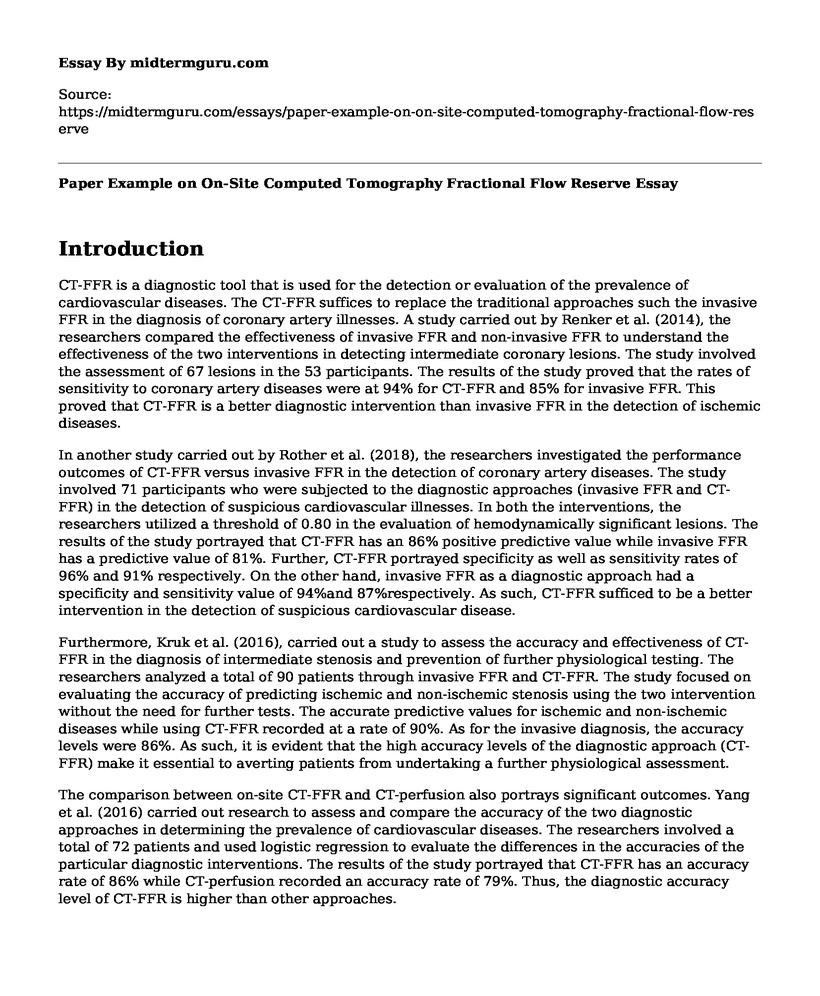Introduction
CT-FFR is a diagnostic tool that is used for the detection or evaluation of the prevalence of cardiovascular diseases. The CT-FFR suffices to replace the traditional approaches such the invasive FFR in the diagnosis of coronary artery illnesses. A study carried out by Renker et al. (2014), the researchers compared the effectiveness of invasive FFR and non-invasive FFR to understand the effectiveness of the two interventions in detecting intermediate coronary lesions. The study involved the assessment of 67 lesions in the 53 participants. The results of the study proved that the rates of sensitivity to coronary artery diseases were at 94% for CT-FFR and 85% for invasive FFR. This proved that CT-FFR is a better diagnostic intervention than invasive FFR in the detection of ischemic diseases.
In another study carried out by Rother et al. (2018), the researchers investigated the performance outcomes of CT-FFR versus invasive FFR in the detection of coronary artery diseases. The study involved 71 participants who were subjected to the diagnostic approaches (invasive FFR and CT-FFR) in the detection of suspicious cardiovascular illnesses. In both the interventions, the researchers utilized a threshold of 0.80 in the evaluation of hemodynamically significant lesions. The results of the study portrayed that CT-FFR has an 86% positive predictive value while invasive FFR has a predictive value of 81%. Further, CT-FFR portrayed specificity as well as sensitivity rates of 96% and 91% respectively. On the other hand, invasive FFR as a diagnostic approach had a specificity and sensitivity value of 94%and 87%respectively. As such, CT-FFR sufficed to be a better intervention in the detection of suspicious cardiovascular disease.
Furthermore, Kruk et al. (2016), carried out a study to assess the accuracy and effectiveness of CT-FFR in the diagnosis of intermediate stenosis and prevention of further physiological testing. The researchers analyzed a total of 90 patients through invasive FFR and CT-FFR. The study focused on evaluating the accuracy of predicting ischemic and non-ischemic stenosis using the two intervention without the need for further tests. The accurate predictive values for ischemic and non-ischemic diseases while using CT-FFR recorded at a rate of 90%. As for the invasive diagnosis, the accuracy levels were 86%. As such, it is evident that the high accuracy levels of the diagnostic approach (CT-FFR) make it essential to averting patients from undertaking a further physiological assessment.
The comparison between on-site CT-FFR and CT-perfusion also portrays significant outcomes. Yang et al. (2016) carried out research to assess and compare the accuracy of the two diagnostic approaches in determining the prevalence of cardiovascular diseases. The researchers involved a total of 72 patients and used logistic regression to evaluate the differences in the accuracies of the particular diagnostic interventions. The results of the study portrayed that CT-FFR has an accuracy rate of 86% while CT-perfusion recorded an accuracy rate of 79%. Thus, the diagnostic accuracy level of CT-FFR is higher than other approaches.
Conclusion
To conclude, it is evident that the results of the various studies portray CT-FFR as an essential intervention that increases the diagnostic accuracy levels in the detection of coronary heart diseases. Subsequently, the high levels of accuracy ensure that the patients do not undergo further physiological evaluation. As such, the utilization of on-site CT-FFR is essential to facilitate the effectiveness in the diagnoses of coronary artery diseases. As a recent discovery, the physicians and other professional healthcare providers should consider integrating the diagnostic approach into practice for accurate assessment of suspicious coronary artery diseases.
References
Kruk, M., Wardziak, L., Demkow, M., Pleban, W., Pregowski, J., Dzielinska, Z., ... & Kepka, C. (2016). Workstation-based calculation of CTA-based FFR for intermediate stenosis. JACC: Cardiovascular Imaging, 9(6), 690-699.
Renker, M., Schoepf, U. J., Wang, R., Meinel, F. G., Rier, J. D., Bayer II, R. R., ... & Baumann, S. (2014). Comparison of diagnostic value of a novel noninvasive coronary computed tomography angiography method versus standard coronary angiography for assessing fractional flow reserve. The American journal of cardiology, 114(9), 1303-1308.
Rother, J., Moshage, M., Dey, D., Schwemmer, C., Trobs, M., Blachutzik, F., ... & Marwan, M. (2018). Comparison of invasively measured FFR with FFR derived from coronary CT angiography for detection of lesion-specific ischemia: Results from a PC-based prototype algorithm. Journal of cardiovascular computed tomography, 12(2), 101-107.
Yang, D. H., Kim, Y. H., Roh, J. H., Kang, J. W., Ahn, J. M., Kweon, J., ... & Kang, S. J. (2016). Diagnostic performance of on-site CT-derived fractional flow reserve versus CT perfusion. European Heart Journal-Cardiovascular Imaging, 18(4), 432-440.
Cite this page
Paper Example on On-Site Computed Tomography Fractional Flow Reserve. (2022, Sep 26). Retrieved from https://midtermguru.com/essays/paper-example-on-on-site-computed-tomography-fractional-flow-reserve
If you are the original author of this essay and no longer wish to have it published on the midtermguru.com website, please click below to request its removal:
- Family Response to Chronic Illness and Disability - Essay Sample
- Cliental in a Nursing Homes - Paper Example
- Essay Example on Holistic Nursing
- Essay on the Drug Enforcement Techniques and Programs
- Essay Sample on Racial Tensions in America
- Standardized Nursing Language: Enhancing Communication & Care - Essay Sample
- Nurses Key to Providing Well-Being to Homeless in Phoenix Rescue Mission - Essay Sample







